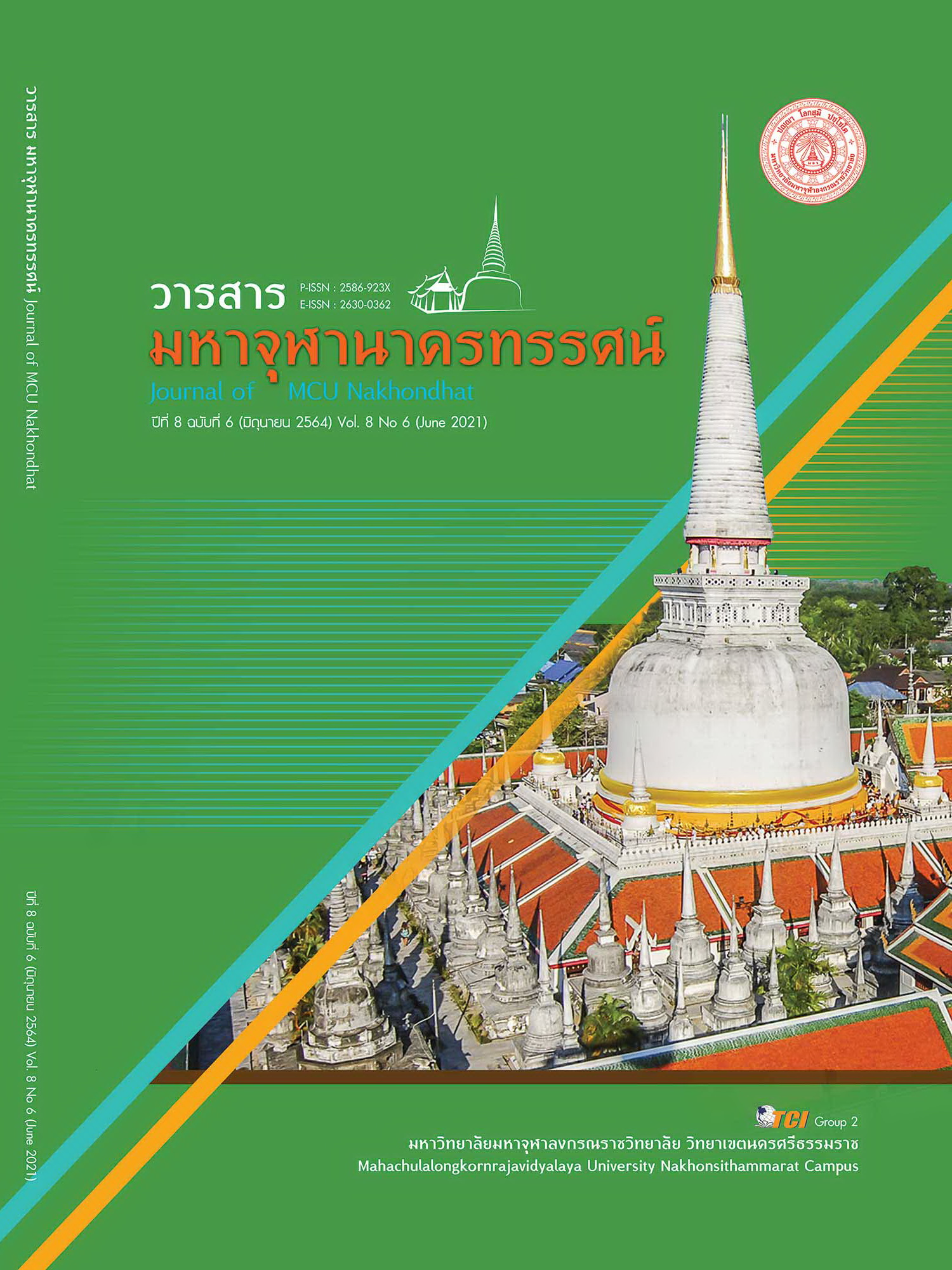FACTORS INFLUENCING THE DRIVING BEHAVIOR CAUSING THE TRAFFIC RULE VIOLATION ON STATE HIGHWAY
Main Article Content
Abstract
The objectives of this research were to investigate 1) the driving behavior causing the traffic rule violation on state highway, 2) factors influencing the driving behavior causing the traffic rule violation on state highway, and 3) to examine the suggestion for proper solution for the traffic rule violation. The research design was mixed methods. The quantitative research approach involved 384 participants selected from the infinite population driver who experienced using the State Highway. The self - administrated questionnaire was used for data collection. Data analysis included descriptive statistics, Multiple Regression Analysis (MRA), t - Test F - Test (One - way ANOVA) Chi2. The research findings indicated that; 1) The 72.1 percentage of the sample group used to drive over a speed limit both intentionally and unintentionally. This illustrated the moderate level of risky driving behavior, with an average of 2.26. 2) The analysis of Chi2 t - Test F Test showed that the significant factors influencing over - speed driving behavior and risky driving behaviors were gender, age, marital status, average monthly income, driving experience, and personal records of getting traffic ticket in the past 3 years. 3) The suggestions and guidance for the solutions were to include legalizing effective law enforcement, appropriate punishment, cooperation with other agencies. The research provided the recommendation for policy aspect, practice and further research.
Article Details
References
ณัฐฐ์วัฒน์ สุทธิโยธิน. (2554). ทฤษฎีอาชญาวิทยา: แนวการศึกษา ชุดวิชากฎหมายอาญาและอาชญาวิทยาชั้นสูง หน่วยที่ 5 สาขาวิชานิติศาสตร์. นนทบุรี: มหาวิทยาลัยสุทัยธรรมาธิราช.
ธนาภรณ์ ติยะบุตร และคณะ. (2558). การประยุกต์ใช้ทฤษฎีพฤติกรรมตามแผนเพื่อศึกษาปัจจัยที่มีผลต่อความตั้งใจของผู้ขับขี่รถจักรยานยนต์ใน การฝ่าสัญญาณไฟแดง. ใน การประชุมวิชาการวิศวกรรมโยธาแห่งชาติ ครั้งที่ 20 วันที่ 8 - 10 กรกฎาคม 2558 จังหวัดชลบุรี. วิศวกรรมสถานแห่งประเทศไทย ในพระบรมราชูปถัมภ์ (ว.ส.ท.).
นัทธี จิตสว่าง. (2541). หลักทัณฑวิทยา. กรุงเทพมหานคร: โรงพิมพ์ราชทัณฑ์.
นิภา เสียงสืบชาติ. (2549). ปัจจัยที่มีผลต่อพฤติกรรมการขับขี่ของผู้ขับขี่รถจักรยานยนต์แผนกอุบัติเหตุฉุกเฉินโรงพยาบาลเลิดสิน. ใน วิทยานิพนธ์วิทยาศาสตรมหาบัณฑิต สาขาสุขศึกษา. มหาวิทยาลัยศรีนครินทรวิโรฒ.
บีบีซี เวิลด์ นิวส์ (BBC). (2561). WHO: อุบัติเหตุบนท้องถนนทำให้คนหนุ่มสาวเสียชีวิตมากที่สุด ส่วนไทยครองแชมป์อัตราการตายบนถนนสูงสุดในเอเชียตะวันออกเฉียงใต้? เรียกใช้เมื่อ 5 พฤษภาคม 2563 จาก https://www.bbc.com/thai/international-46545106
ปัญญ จันทรสุขโข. (2556). ปัจจัยที่มีความสัมพันธ์ต่อการกระทาผิดกฎจราจรของผู้ขับขี่รถจักรยานยนต์. วารสารวิทยบริการ, 24(1), 51-60.
พิชญ์สินี กุลเอกสรชา และคณะ. (2563). การศึกษาพฤติกรรมการใช้ความเร็วและพฤติกรรมการขับขี่บนถนนชานเมืองจังหวัดชลบุรี. ใน การประชุมวิชาการวิศวกรรมโยธาแห่งชาติ ครั้งที่ 25 วันที่ 15-17 กรกฎาคม 2563 จ.ชลบุรี. วิศวกรรมสถานแห่งประเทศไทย ในพระบรมราชูปถัมภ์ (ว.ส.ท.).
วัชรพล อิ่มจรูญ. (2547). ปัจจัยที่สัมพันธ์กับพฤติกรรมการขับรถแท็กซี่ในกรุงเทพมหานคร. ใน วิทยานิพนธ์สังคมศาสตรมหาบัณฑิต สาขาสังคมศาสตร์เพื่อการพัฒนา. มหาวิทยาลัยราชภัฏบ้านสมเด็จเจ้าพระยา.
หน่วยวัดความปลอดภัยทางถนน. (2564). สถานการณ์อุบัติเหตุทางถนนในภาพรวม. เรียกใช้เมื่อ 25 เมษายน 2564 จาก http://trso.thairoads.org
Ajzen, I. (1985). From intentions to actions: A theory of planned behavior. In Kuh, J. & Beckmann, J. (Ed). Action Control (pp. 11-39). Heidelberg, Germany: Springer-Verlag.
Bjornskau, T. et al. (1992). Can road traffic law enforcement permanently reduce the number of accidents? Accid Anal & Prev, 24(5), 507-520.
Cochran, W. G. (2007). Sampling techniques. Hoboken, New Jersey: John Wiley & Sons, Inc.
Cornish, D. et al. (1987). Understanding crime displacement: an application of rational choice theory. Criminology, 25(4), 933–947.
Eyal, P. (2010). Speeding and the time-saving bias: How drivers’ estimations of time saved in higher speed affects their choice of speed. Accident Analysis and Prevention, 42(2010). 1978-1982.
Martinussena, L. et al. (2013). Age, gender, mileage and the DBQ: The validity of the Driver Behavior Questionnaire in different driver groups. Accident Analysis and Prevention, 52(2013), 228-236.
Rosli, N. et al. (2017). Testing the Driving Behavior Questionnaire (DBQ) on Malaysian Drivers. The Proceeding of the 12th Malaysian Universities Transport Research Forum Conference (MUTRFC 2017). In Conjunction With 4th Agkn On Tour 15. Universiti Teknologi Mara, Selangor.
Warner, H. et al. (2010). Can the traffic locus of control (T-LOC) scale be successfully used to predict Swedish drivers’ speeding behavior? Accident Analysis and Prevention, 42(2010), 1113-1117.


